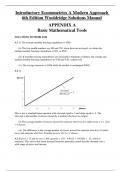Exam (elaborations)
Complete Solution Manual Introductory Econometrics A Modern Approach 6th Edition Wooldridge (Chapter 1-19)
- Course
- Institution
- Book
Introductory Econometrics A Modern Approach 6th Edition Wooldridge Solutions Manual Complete Solution Manual Introductory Econometrics A Modern Approach 6th Edition Wooldridge (Chapter 1-19) PDF File All Pages All Chapters Grade A+
[Show more]



